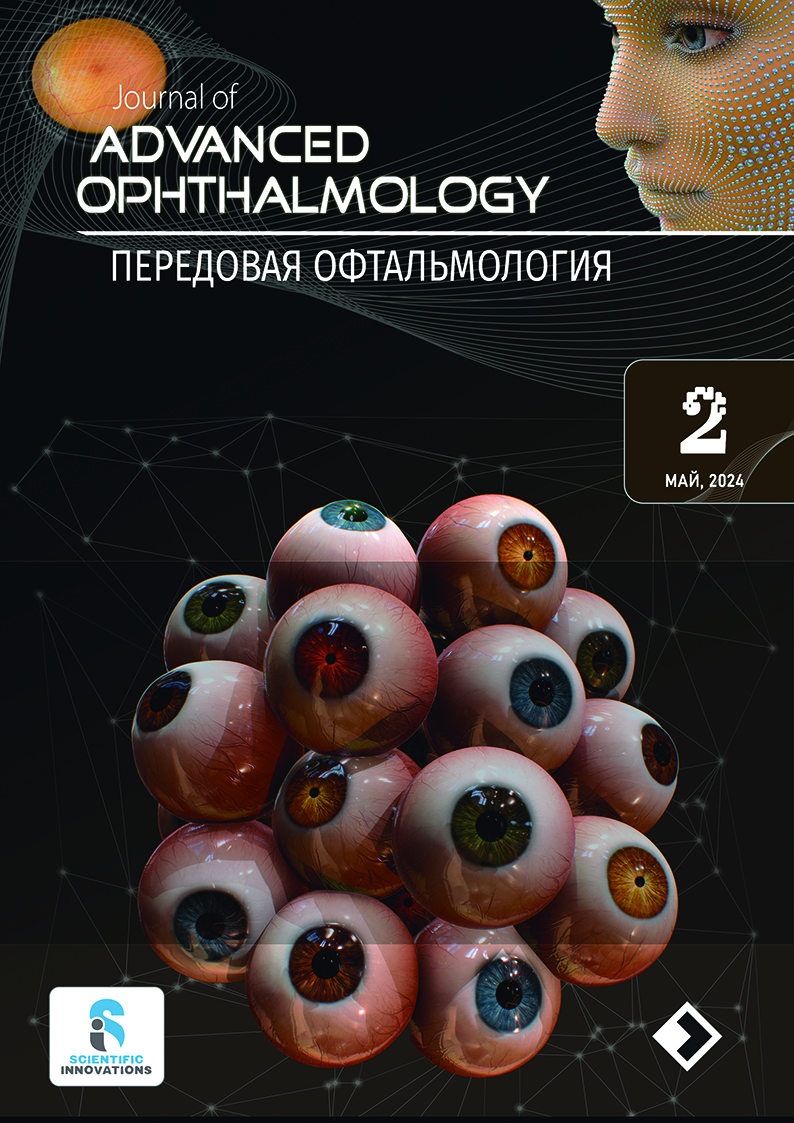ОПЫТ ПРИМЕНЕНИЯ АНАЛИЗАТОРА БИОМЕХАНИЧЕСКИХ СВОЙСТВ РОГОВИЦЫ CORVIS ST В ОТБОРЕ ПАЦИЕНТОВ НА КЕРАТОРЕФРАКЦИОННУЮ ХИРУРГИЮ
DOI:
https://doi.org/10.57231/j.ao.2024.8.2.004Ключевые слова:
кераторефракционная хирургия, ЛКЗ — лазерная коррекция зрения, вторичная эктазия, Corvis ST, Pentacam, TBIАннотация
Вторичная эктазия после лазерной коррекции остается тяжелым осложнением кераторефракционной хирургии. Статистика эктазий после различных кераторефракционных вмешательств показывает более частое развитие данного осложнения после лоскутных методик лазерной коррекции зрения (LASIK, FemtoLASIK), чем после методик поверхностной абляции (ФРК, транс ФРК, LASEK), a рост количества случаев эктазии после лентикулярной хирургии должен вызывать настороженность. Ранее существовавший кератоконус может играть более значимую роль в развитии послеоперационной эктазии, чем это учтено в литературе, в связи с чем особую важность приобретает ранняя диагностика не просто доклинической стадии кератоконуса, а выявление факторов предрасположенности к развитию эктазии на глазах с нормальными кератотопографическими характеристиками. Последние разработки в области ранней диагностики эктазий используют возможности искусственного интеллекта в анализе биомеханических свойств и геометрии роговицы для выявления предрасположенности роговицы к эктазии. В статье проанализирован собственный опыт использования диагностического комплекса Pentacam + Corvis ST в отборе пациентов на кераторефракционные вмешательства.
Библиографические ссылки
T Seiler 1, A W Quurk. Iatrogenic keratectasia after LASIK in a case of formefruste keratoconus. J Cataract Refract Surg. 1998;24(7):1007-9. https://doi.org/10.1016/s0886-3350(98)80057-6
T Seiler 1, K Koufala, G Richter. Iatrogenic keratectasia after laser in situ keratomileusis. J Refract Surg. 1998;14(3):312-7. https://doi.org/10.3928/1081-597x-19980501-15
J. Bradley Randleman, MD; Maria Woodward, MD; Michael J. Lynn, MS; R. Doyle Stulting, MD, PhD. Risk Assessment for Ectasia after Corneal Refractive Surgery. J. Ophthalmology. 2007. https://doi.org/10.1016/j.ophtha.2007.03.073
Nir Sorkin, Igor Kaiserman, Yuval Domniz, TzahiSela, Gur Munzer, and David Varssano. Risk Assessment for Corneal Ectasia following Photorefractive Keratectomy. J Ophthalmol. 2017; https://doi.org/10.1155/2017/2434830
Majid Moshirfar, corresponding, Alyson N. Tukan, NourBundogji, Harry Y. Liu, Shannon E. McCabe, Yasmyne C. Ronquillo, and Phillip C. Hoopes. Ectasia After Corneal Refractive Surgery: A Systematic Review. OphthalmolTher. 2021; 10(4): 753–776https://doi.org/10.1007/s40123-021-00383-w
Renato Ambrósio Jr. Post-LASIK Ectasia: Twenty Yearsofa Conundrum. Semin Ophthalmol. 2019;34(2):66-68. https://doi.org/10.1080/08820538.2019.1569075
Ambrosio R Jr, KlyceSD, Wilson SE. Corneal topographic and pachymetric screening of keratorefractive patients. J Refract Surg.2003;19(1):24-29.https://doi.org/10.3928/1081-597x-20030101-05
Randleman JB, Russell B,Ward MA,et al. Risk factors and prognosis for corneal ectasia after LASIK. Ophthalmology. 2003;110(2):267-275https://doi.org/10.1016/s0161-6420(02)01727-x
J Bradley Randleman, William B Trattler, R Doyle Stulting. Validation of the Ectasia Risk Score System for preoperative laser in situ keratomileusis screening. J Ophthalmol. 2008;145(5):813-8. https://doi.org/10.1016/j.ajo.2007.12.033
Ambrosio R Jr, Nogueira LP, Caldas DL, et al. Evaluation of corneal shape and biomechanics before LASIK. Int Ophthalmol Clin. 2011;51(2):11-38https://doi.org/10.1097/iio.0b013e31820f1d2d
Marcony R Santhiago, Natalia T Giacomin, David Smadja, Samir J Bechara. Ectasia risk factors in refractive surgery. Clin Ophthalmol. 2016; 20:10:713-20. https://doi.org/10.2147/opth.s51313
Yangieva N.R., Tuychibaeva S.S., Agzamova S.S. Current state of the issue on the problem of morbidity and disability in ophthalmopathology. Advanced ophthalmology. 2023; 5(5): 77-83. DOI: https://doi.org/10.57231/j.ao.2023.5.5.014
Tuychibaeva D. Epidemiological and clinical-functional aspects of the combined course of age-related macular degeneration and primary glaucoma. J.ophthalmol. (Ukraine). 2023;3:3-8. https://doi.org/10.31288/oftalmolzh2023338
Yaowen Song 1, Yi Feng, Min Qu, Qiuxia Ma, Huiqin Tian, Dan Li, Rui He. Analysis of the diagnostic accuracy of Belin/Ambrósio Enhanced Ectasia and Corvis ST parameters for subclinical keratoconus. Int Ophthalmol. 2023;43(5):1465-1475. https://doi.org/10.1007/s10792-022-02543-8
Renato Ambrósio Jr, Bernardo T Lopes, Fernando Faria-Correia, Marcella Q Salomão, Jens Bühren, Cynthia J Roberts, Ahmed Elsheikh, Riccardo Vinciguerra, Paolo Vinciguerra. Integration of Scheimpflug-Based Corneal Tomography and Biomechanical Assessments for Enhancing Ectasia Detection. J Refract Surg.2017;33(7):434-443. https://doi.org/10.3928/1081597x-20170426-02
José Ferreira-Mendes, Bernardo T Lopes, Fernando Faria-Correia, Marcella Q Salomão, Sandra Rodrigues-Barros, Renato Ambrósio Jr. Enhanced Ectasia Detection Using Corneal Tomography and Biomechanics. J Ophthalmol. 2019:197:7-16. https://doi.org/10.1016/j.ajo.2018.08.054
Mingyue Zhang, Fengju Zhang, Yu Li, Yanzheng Song, Zhiqun Wang. Early Diagnosis of Keratoconus in Chinese Myopic Eyes by Combining Corvis ST with Pentacam Curr Eye Res. 2020;45(2):118-123. https://doi.org/10.1080/02713683.2019.1658787
Загрузки
Опубликован
Выпуск
Раздел
Лицензия
Copyright (c) 2024 Беликова Е. И., Перова Т. В.

Это произведение доступно по лицензии Creative Commons «Attribution-NonCommercial-NoDerivatives» («Атрибуция — Некоммерческое использование — Без производных произведений») 4.0 Всемирная.

